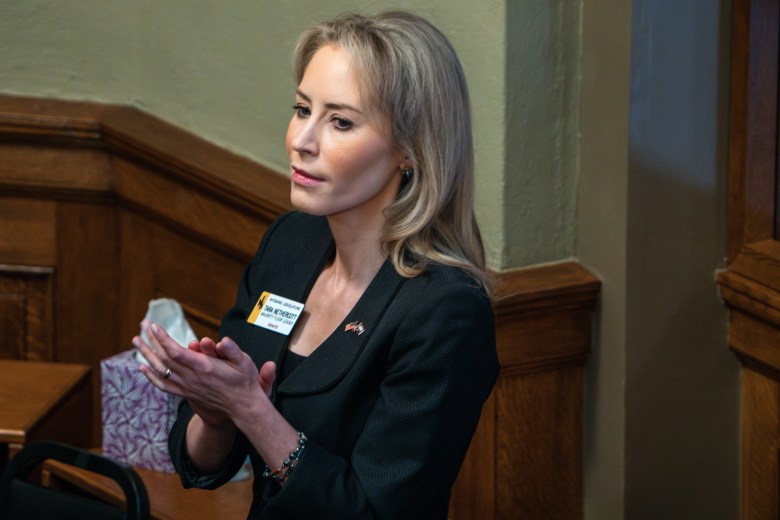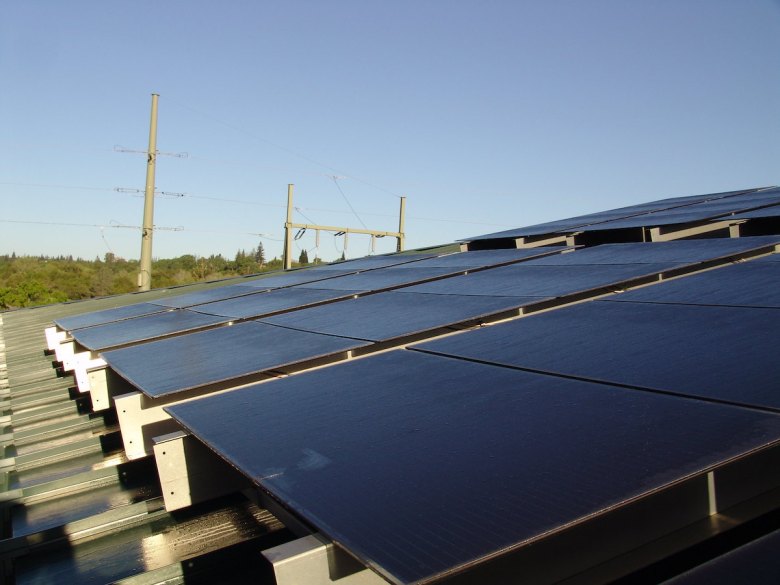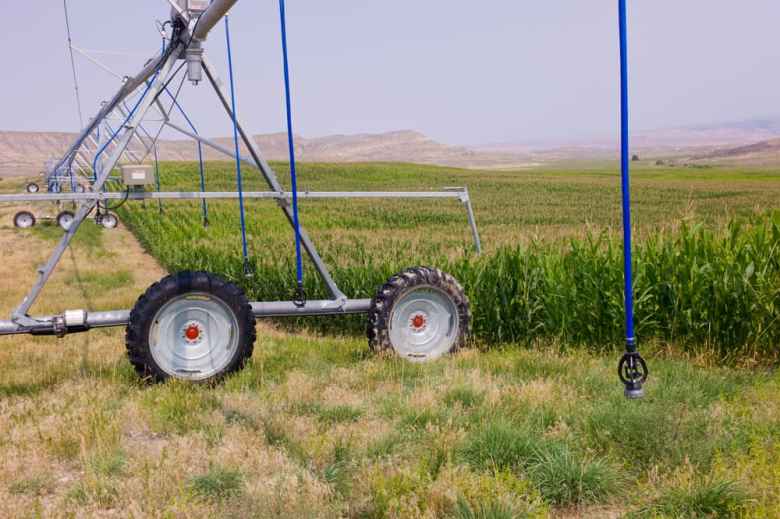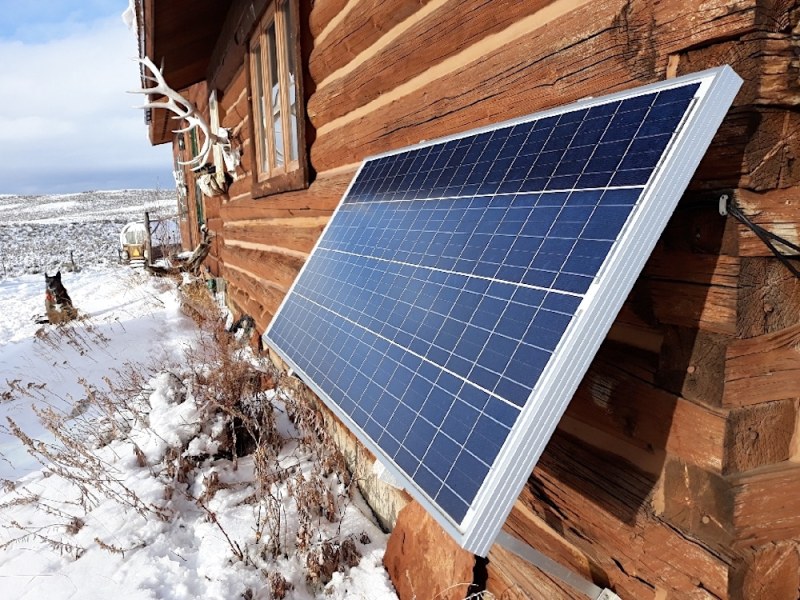Cokeville area farmer Jason Thornock testified to lawmakers that the rising cost of electricity threatens his livelihood.
Family agricultural operations are “dealing with these monopolistic utilities — they’re monopolies,” Thornock said. “They hold tremendous power. Incredible power. It’s their way or the highway. There’s no negotiating with them.
“This year they’re asking for [a] 15% [rate hike],” Thornock continued. “Next year, they’ll ask for 15%. My power bill now is $150,000 a year. I’m not the biggest farmer in Wyoming, by no means.”
Thornock and others in agriculture said they want to invest in solar technology to make ends meet, and they’ve found support among conservation groups, and even town officials who want to do the same.
A measure to achieve that goal weathered skepticism to clear first the House and then a Senate committee. But in surmounting those hurdles, the legislation has morphed into something that proponents say could do more harm to the cause than good.
House Bill 183, “Net metering amendments” would expand the size of solar installations that qualify for net metering (i.e. reimbursement from the utility company for excess produced power) from 25 kilowatts of self-generation to 200 kilowatts. Expanding the qualification, proponents say, would bring the benefits of net metering beyond homes to ranching operations, churches and potentially even schools and municipal facilities.

The bill cleared the Senate Minerals, Business and Economic Development Committee on Tuesday, but not before it was significantly altered. Lawmakers amended the bill in a way that appears to expose all net-metering customers to as-yet-undefined new fees, jeopardizing its support among agriculture communities and municipalities.
Cheyenne Republican Sen. Tara Nethercott, who brought the amendment, said it was a condition of her support for the bill, and it’s based on a perception that net-metering customers might not pay a fair share of the utility system costs necessary to keep them connected to the grid.
“I understand the need for alternative sources of energy, because sometimes those energy demands can’t be met,” Nethercott said. “But we have to continue to pay into the grid.”
Some net-metering proponents consider the measure a poison pill.
“Those of us who supported HB 183 previously are still sorting out whether it is salvageable,” rooftop solar provider Creative Energies co-founder Scott Kane told WyoFile.
Case for raising the cap
After fending off a perennial legislative attempt to reduce credits for residential rooftop solar users, proponents of self-generated electricity were excited at the prospect of expanding Wyoming’s net-metering law — the system of earning credits for personal power generation that sometimes pumps electricity into the grid for utilities to sell to other customers.
How Wyoming net-metering works
Net-metering laws apply to residential and small-business customers with 25-kilowatt or smaller solar arrays. According to state law, qualifying residential and small-business net-metering customers must be credited for the excess power they generate, but don’t use, and supply back into the system for other customers to use.
For example, if a customer uses 1,000 kilowatt hours in a month, but generates 1,200 kilowatt hours during the same period, sending a net 200 kilowatt hours of electricity back into the system, the utility must credit that customer for 200 kilowatt hours in the next monthly billing cycle. That kilowatt-hour-for-kilowatt-hour exchange occurs at the retail rate. Unused credits rollover month-to-month.
But, to disincentivize net-metering customers from vastly overbuilding a personal solar array to game the system, any leftover credits at the end of the year are paid out to the customer at the utility’s lower wholesale rate.
The higher cap, they say, would extend Wyoming’s net-metering credit system to non-residential customers such as towns, ranches and perhaps even school districts that want to invest in solar arrays to reduce their dependence on, and monthly payments to, the commercial and member-owned electric utilities they are beholden to. Those utilities, including Wyoming’s largest electric provider Rocky Mountain Power, have been raising rates by historic leaps in recent years, threatening the viability of ranching operations that rely on a large amount of electricity to power things such as water wells and pivots, according to some.
Not only would raising the cap help stem rising utility expenses for ranching operations and enable municipalities to save taxpayer dollars — concepts that are very much in line with the energy independence and government efficiency values espoused by Wyoming elected officials — proponents say it would also help reduce the need for utilities to invest in expensive new power generation. Those costs lead to rate hikes, utilities have testified, and they include constructing wind and solar farms in previously undisturbed areas.

“Our organization works hard on renewable [energy] siting issues to ensure that renewable energy is not a negative impact on Wyoming’s wildlife and our precious, sensitive landscapes,” said Monika Leininger, director of external affairs and climate policy for The Nature Conservancy in Wyoming. “We see net metering as a solution to help address that issue, particularly in the face of increasing power demands across the country and across the state.”
Cost shift concerns
There have long been lingering suspicions that those who earn credits for the excess power they contribute to the grid don’t pay a fair share of system-delivery costs. Though state officials who regulate monopoly utility rates say there is a potential cost shift from net-metering customers to other customers, it’s too minuscule to quantify.
Senate File 111, “Net metering revisions,” attempted to address those concerns by empowering state regulators and co-ops to assess charges to make up for a cost shift, but the measure failed its third reading on the Senate floor.
Now, the amended HB 183 is moving in the Senate, but proponents of the original version are lobbying against the changes. The Nethercott amendment would strike a section of the 2001 net-metering statute that protected all net-metering customers from additional fees. It didn’t include any replacement language specifying what those fees might be or who has the authority to impose them. It also doesn’t specify whether those with existing rooftop solar systems might now be exposed to new fees.
Rooftop solar advocates have pointed to a recent Wyoming Supreme Court decision that they say shows utilities can’t be trusted to impose reasonable compensation to net-metering customers.
“So it went from [a simple expansion] to what now could degrade the value of solar for everybody,” Kane said.
Correction: This story has been updated to correct the spelling of Jason Thornock’s name. —Ed




As some one who has been net metering since 2004, I continue,as I should, paying a monthly service fee, to delivery services. Now nearly $50 per month. I am very tired of seeing legislators and lobbyist continue session after session to amend and change this law in adverse impacts against those that generate clean energy. Our REA filed avoided costs were reduced recently to about 2.5 c/kWh while retail is about 12.2 c/kWh. When we generate and feed the grid excess what happens to those electrons? They go to my neighbors who are subsequently charged 12.2 c/kWh by our COOP. For no capitol expense utility companies are reaping this benefit. Distributed generation or off grid is the future. Solar PV technology and battery technology are moving fast, but mostly in more progressive and innovative places then WY!
The issues with “alternative”energy generation in Wyoming are real, but a comprehensive, forward-looking approach is beyond the reach of either HB 183 or SF 111 (the other “net metering” bill). That roof-top solar is such a tiny fraction of the power system argues against the need for some immediate “solutions”, but there remains the long-term need for a careful review of electricity rate structures as we gradually move toward a more alternative-rich future.
SF 111 sought to highlight and “correct” a perceived subsidy for rooftop solar owners (of which I am one). A major element of that subsidy is that customers (all customers) do not pay the fixed costs of their electrical service in the “service charge” on their monthly bill. Instead, much of the utility’s fixed costs have been shifted into the per-kWhr charges. Anything a user does to conserve energy – insulation, new windows, turning down the thermostat, installing solar panels – means lower kWhr charges and thus, a reduced share of the fixed costs of service. This is a cost-shift favoring anyone trying to save energy, by any means.
As Senator Case put it in his committee testimony on SF 111, this cost-shift (call it a “subsidy” if you like) “has one purpose – to provide very small users with small bills”. Helping out small users (of all types) is a policy decision, which is within the purview of the legislature. That the present rate structure regarding rooftop solar encourages that industry should be understood, but is also a policy decision I support. HB 183 extends that encouragement, and should be supported as well.
On the other hand, the power companies’ concern that they may have to build and maintain infrastructure to backstop alternative energy sources (of all sorts) is not unfounded. Rather than passing legislation trying to “fix” something that is certainly not “broken” at this point, our experts should be charged with objectively sorting out the various subsidies, overt and hidden, in utility rate structures across the boards and providing that information to the legislature to guide well-informed policy decisions in the best interests of Wyoming citizens.
In the meantime, we solar users should consider our own demand management, shifting use patterns to the extent feasible to minimize the need for backup grid power.
– Bern Hinckley
Laramie
In Western WY, we have a power co-op, Lower Valley Energy, not an out of state monopoly that operates solely for profit. Our electric power is the lowest price in the nation. It is so low that solar is hardly worth doing, and members even get a dividend check. Leave the monopolies and organize a co-op!